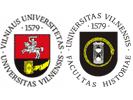In 1939 the Baltic states became the victims of cruel Hitler and Stalin agreements. Hitler and Stalin agreed that the German minority from the Baltic states would repatriate to Germany. Since 1939 till 1944 more than one million of Germans were forced to leave over 40 states and to settle down in Germany. In 1923 in Lithuania there lived 28 thousands 671 Germans or 1.5 per cent of population. In 1940 there were 36 thousands of Germans. The number of Germans increased because of Nazi agitation, then Lithuanians changed their nationality into German. In Latvia in 1930 there lived about 70 thousands and in Estonia – 16 thousands of Germans. In 1939 from Latvia repatriated more than 50 thousands of Germans, from Estonia – about 13 thousands 700 Germans. In 1940 repeatedly 18 thousands of Germans were forced to leave Estonia and Latvia. The repatriation from Lithuania was executed in winter of 1941, more than 50 thousands of Germans and Lithuanians left the country.
German historians the preparation for repatriation ascripted to German community. In fact German community was directed by local Nazi organizations and its leaders. German historians agree, that the news from Berlin about the German repatriation first were given to the leaders of the Nazi movement in the Baltic states. Although there are some historical researches, nobody noticed what important role had played the Nazi organizations during the German repatriation. The leaders of the Nazi movement in the Baltic states were at the same time the leaders of the German community. Nazi movement had thousands of members, it received instructions and financial support from Berlin. German historians made an impression that German community obeyed Hitler’s order and made its‘ best to leave the country as quick as possible.
The German Nazi movement (Bewegung) was especially active in Latvia, leaded by Erhard Kroeger. The Nazi organization in Estonia was directed by Oskar Lutz and baron Wrangel, the president of German community. On 25th of September 1939 E. Kroeger visited Hitler in his staff in Poland. E. Kroeger informed Hitler about the political situation in Latvia and asked him to rescue the Baltic Germans. During the secret negotiations between Hitler and Stalin the question of Germans in the Baltic states was discussed too. On the 2nd of October the leaders of Baltic Nazi organizations were informed about Hitler’s decision to transfer German minority from Estonia and Latvia to Germany. On the 6th of October Hitler officially proclaimed about the repatriation from the Baltic states. The „Rigasche Rundschau“ published the proclamation of E. Kroeger about the preparation for the repatriation. In three weeks the Germans abdicated previous citizenship, transferred their personal property to special German institutions and with small luggage left the country.
In autumn of 1939 Nazi organization Kulturverband in Lithuania also started preparation for German repatriation. But the negotiations with Lithuanian authorities did not start. After secret agreements between Hitler and Stalin, Lithuania should be handed to the Soviets. The German and Soviet negotiations started in 1940 after the Soviets occupied Lithuania. Although Hitler did not proclaimed the German repatriation from Lithuania, practically the German minority was prepared for it. Berlin ordered Kulturverband to give real figures about German minority in Lithuania. The leaders of Kulturverband R. Kosmann, K. Cerpinski, O. Reichard, von der Ropp and E. Klug controlled the community, spread the information about repatriation and followed the instructions from Berlin. The leaders of Kulturverband were told about the place were the German minority from Lithuania would be settled down. In comparison with repatriation from Latvia and Estonia, Lithuanian German minority experienced hardship and suffered losses because the preparation continued about two years (Since October 1939 till the March of 1941).
Nazi organizations in the Baltic states fulfilled the instructions of German SS and other institutions: made registration of Germans and their property, gave new documents for the repatriates, spread the information. Nazi organizations in the Baltic states helped German institutions to execute the repatriation in a short time. | 

 dizainas ir programavimas giriaus
dizainas ir programavimas giriaus  dizainas ir programavimas giriaus
dizainas ir programavimas giriaus